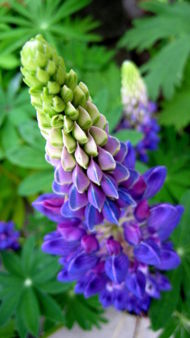Lupinus perennis
| Lupinus perennis subsp. var. | ||||||||||||||||||||||||||||||||||||||||||||||||||||||||
|---|---|---|---|---|---|---|---|---|---|---|---|---|---|---|---|---|---|---|---|---|---|---|---|---|---|---|---|---|---|---|---|---|---|---|---|---|---|---|---|---|---|---|---|---|---|---|---|---|---|---|---|---|---|---|---|---|

|
|
| ||||||||||||||||||||||||||||||||||||||||||||||||||||||
| ||||||||||||||||||||||||||||||||||||||||||||||||||||||||
| Standard Cyclopedia of Horticulture |
|---|
|
Lupinus perennis, Linn. Sun-Dial. Common Wild Lupine. St. erect, 1-2 ft. high, rather stout, minutely pubescent: lvs. long-petioled, soft-downy; 1fts. 7-9, obovate-oblong to lanceolate, obtuse, glabrous above, soft-downy below: fls. in large, loose terminal spikes or racemes, alternate, blue, varying to white. June, July. Canada to Fla. B.M. 202. Mn. 6:101. B.B. 2:269. Desirable species, growing in the poorest soil, preferring sandy land. Grows from subterranean rootstocks.
|
| Lupinus perennis {{{status}}} Fossil range: {{{fossil_range}}}
| ||||||||||||||||||||||||||||||||||||||||||||||||||||||||||||||||||
|---|---|---|---|---|---|---|---|---|---|---|---|---|---|---|---|---|---|---|---|---|---|---|---|---|---|---|---|---|---|---|---|---|---|---|---|---|---|---|---|---|---|---|---|---|---|---|---|---|---|---|---|---|---|---|---|---|---|---|---|---|---|---|---|---|---|---|
 Young Perennial Lupin (Lupinus perennis) | ||||||||||||||||||||||||||||||||||||||||||||||||||||||||||||||||||
| Plant Info | ||||||||||||||||||||||||||||||||||||||||||||||||||||||||||||||||||
| ||||||||||||||||||||||||||||||||||||||||||||||||||||||||||||||||||
| Scientific classification | ||||||||||||||||||||||||||||||||||||||||||||||||||||||||||||||||||
(Wats.) Kurl."
| ||||||||||||||||||||||||||||||||||||||||||||||||||||||||||||||||||
| [[{{{diversity_link}}}|Diversity]] | ||||||||||||||||||||||||||||||||||||||||||||||||||||||||||||||||||
| {{{diversity}}} | ||||||||||||||||||||||||||||||||||||||||||||||||||||||||||||||||||
| Binomial name | ||||||||||||||||||||||||||||||||||||||||||||||||||||||||||||||||||
| Lupinus perennis L. | ||||||||||||||||||||||||||||||||||||||||||||||||||||||||||||||||||
| Trinomial name | ||||||||||||||||||||||||||||||||||||||||||||||||||||||||||||||||||
| {{{trinomial}}} | ||||||||||||||||||||||||||||||||||||||||||||||||||||||||||||||||||
| Type Species | ||||||||||||||||||||||||||||||||||||||||||||||||||||||||||||||||||
| {{{type_species}}} | ||||||||||||||||||||||||||||||||||||||||||||||||||||||||||||||||||
| {{{subdivision_ranks}}} | ||||||||||||||||||||||||||||||||||||||||||||||||||||||||||||||||||
| [[Image:{{{range_map}}}|{{{range_map_width}}}|]] | ||||||||||||||||||||||||||||||||||||||||||||||||||||||||||||||||||
| Synonyms | ||||||||||||||||||||||||||||||||||||||||||||||||||||||||||||||||||
| {{{synonyms}}} |
Lupinus perennis (Indian beet, Old maid's bonnets, and Sundial lupine) is a medicinal plant in the Fabaceae family.
It derives only rosette-like radical leaves in the first year of vegetation. Stalks are numerous, erect, striated, slightly pubescent. Leaflets are obovate, with a blunted apex or pointed spear, naked from above, sparsely pubescent from below; their number is 7-11. Petioles are longer then leaflets; stipules are very small, almost missing. The inflorescence is long, sparsely flowered, sometimes almost verticilate. The calyx is silky, without bractlets; its upper labium with a protuberant basis, is integral or weakly emarginate, the lower one is integral, almost twice longer then upper. Floral bracts are styliform, shorter then the calyx, early falling. The corolla is purple or white, three times longer than the calyx. The vexillum is shorter than the wings. The carina is weakly ciliate. Pods are yellow-grayish-brown, with straight lines, necklace-shaped, short and closely hirsute, easy shattered, with 5-6 seeds. Seed is oval with a light hilum. Widespread in the eastern part of the USA (from Florida to Canada), Canada (south of Ontario), and on the coasts of the Arctic Ocean. Lives on sand hills. CLASSIFICATION OF LUPINS